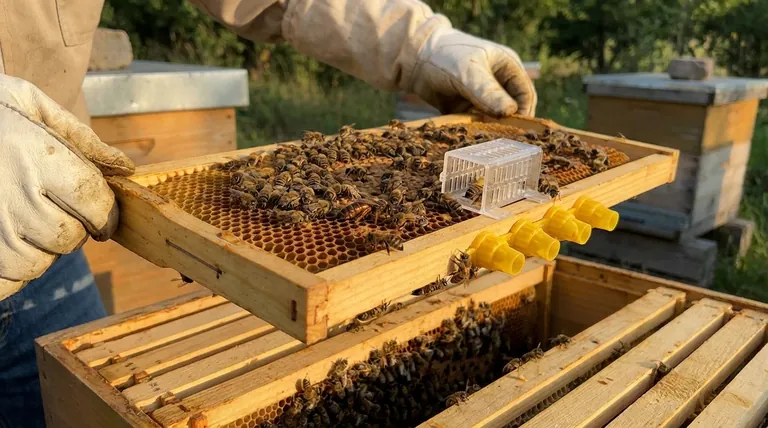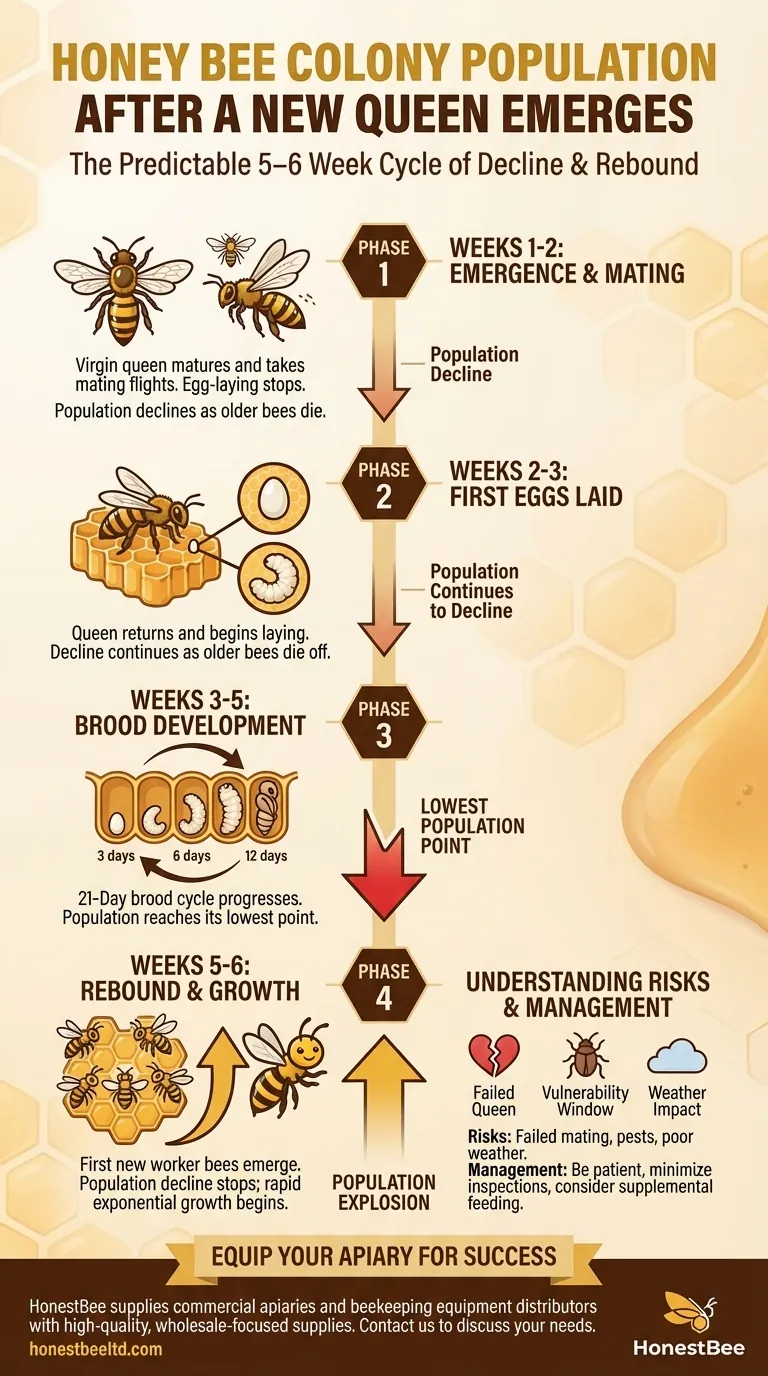In the weeks following a new queen's emergence, a honey bee colony experiences a predictable, temporary decline in population. This shrinkage occurs because there is a gap between the old queen ceasing to lay and the new queen's first offspring maturing into adult bees. Once this new generation of bees begins to emerge, the colony's population will rebound and grow rapidly.
The initial population drop after a new queen appears is not a sign of failure, but a normal and necessary phase. It reflects the time required for the virgin queen to mature, mate, and for her first brood to complete their 21-day development cycle, during which older bees naturally die off.

The Broodless Period: Why a Population Dip is Inevitable
The transition between queens creates a temporary but significant break in the colony's life cycle. This gap in egg-laying is the direct cause of the population dip.
The End of the Old Queen's Reign
A new queen is typically created because the previous queen has died, failed, or left with a swarm. In all these scenarios, egg production stops, and the colony's ability to replenish its population is paused.
The Natural Attrition of Worker Bees
A worker bee's lifespan during the busy summer months is only about six weeks. With no new bees emerging to replace them, the daily death of older bees leads to a steady, noticeable decline in the total number of inhabitants in the hive.
Timeline of a New Queen's Rise
The full process from a queen's birth to the emergence of her first offspring takes several weeks. Understanding this timeline explains why the population dip lasts for the 5–6 week period.
Emergence and Maturation (Week 1)
When a new queen emerges from her cell, she is a virgin and not yet ready to lay eggs. She spends the first several days maturing, building strength, and orienting herself to the hive's location.
The Mating Flights (Week 1-2)
Around 5 to 10 days after emerging, the queen will leave the hive on a series of dangerous mating flights. She must mate with multiple drones in mid-air to become fertile for the rest of her life.
The First Eggs are Laid (Week 2-3)
A few days after successfully mating, the queen will return to the hive and begin laying her first eggs. This moment marks the beginning of the colony's recovery, but the population is still shrinking as older bees continue to die off.
The 21-Day Brood Cycle
From the moment an egg is laid, it takes approximately 21 days for it to develop into a fully-formed adult worker bee. This development cycle progresses from egg (3 days), to larva (6 days), to pupa (12 days).
The Turning Point: Population Rebound
The end of the 5–6 week period marks the critical turning point when the colony's population decline reverses and begins to accelerate.
The First New Bees Emerge (Week 5-6)
Approximately 21 days after the queen began laying (or 5-6 weeks after she first emerged), the first wave of her offspring chews its way out of the wax cells. This is the moment the population decline stops.
Exponential Growth
A healthy, well-mated queen can lay over 1,500 eggs per day. Once her brood begins emerging in large numbers, the colony's population explodes, quickly compensating for the bees lost during the transition period.
Understanding the Risks and Trade-offs
While this population dip is normal, it represents a period of increased vulnerability for the colony.
The Risk of a Failed Queen
The greatest danger is that the new queen is lost on her mating flight or fails to mate successfully. If she does not return or becomes a "drone layer" (laying only unfertilized eggs), the colony is doomed without beekeeper intervention.
The Vulnerability Window
With a smaller workforce, the colony is less capable of defending itself against pests like wax moths and small hive beetles. It is also more susceptible to being robbed of its honey stores by stronger, neighboring colonies.
The Impact of Weather
Prolonged periods of cold, rainy, or windy weather can prevent the queen from taking her mating flights. This extends the broodless period, deepens the population decline, and increases the overall risk to the colony.
How to Manage This Critical Period
As a beekeeper, your role during this time is to be a patient observer, ready to act only if necessary.
- If your primary focus is colony survival: Be patient and minimize inspections. Opening the hive can disturb the new queen and potentially cause the colony to reject her.
- If your primary focus is supporting rapid growth: You can provide light supplemental feeding (1:1 sugar syrup) to ensure the existing bees have ample resources and to encourage the new queen to lay prolifically once she begins.
- If you are concerned about a failed queen: Mark your calendar. If you see no eggs or young larvae 3-4 weeks after the queen was scheduled to emerge, it is time for a careful inspection to confirm she is present and laying correctly.
Understanding this natural cycle of decline and recovery empowers you to confidently guide your colony through one of its most critical transitions.
Summary Table:
| Week | Key Event | Population Impact |
|---|---|---|
| 1-2 | Virgin queen emerges, matures, and takes mating flights. | Egg-laying stops; population begins to decline. |
| 2-3 | Queen returns, begins laying her first eggs. | Decline continues as older bees die off. |
| 3-5 | Brood develops (egg → larva → pupa). | Population reaches its lowest point. |
| 5-6 | First new worker bees emerge. | Population decline stops; rapid growth begins. |
Navigate Queen Transitions with Confidence
Understanding the natural 5-6 week population cycle is crucial for maintaining strong, productive colonies. Equip your apiary with the right supplies to support your hives during this critical period.
HONESTBEE supplies commercial apiaries and beekeeping equipment distributors with high-quality, wholesale-focused beekeeping supplies and equipment. From durable hive components to essential feeding tools, our products are designed to support colony health and maximize your operational efficiency.
Let us help you ensure a successful rebound.
Contact our wholesale experts today to discuss your specific needs and discover how our reliable equipment can benefit your business.
Visual Guide

Related Products
- Jenter Queen Rearing Kit Complete Set for Bee Breeding
- No Grafting Queen Rearing Kit: System for Royal Jelly Production and Queen Rearing
- Nicot Queen Rearing Kit for Beekeeping and Grafting in Nicot System
- JZBZ Langstroth Queen Rearing Frame for Beekeeping
- Durable Galvanized Steel Spring Queen Bee Cage
People Also Ask
- What are the stages involved in queen raising? A Guide to Controlled, High-Quality Queen Production
- What were the size differences among queens reared from worker larvae? Maternal Origin Determines Queen Size
- How can beekeepers start a honey bee breeding program? Build a Superior, Resilient Apiary
- What are the implications of delayed oviposition in queen bees? A Strategy for Superior Queen Quality
- Why is raising queens beneficial for beekeepers? Gain Control Over Genetics and Costs



















